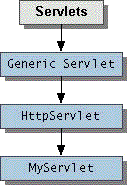Architecture of the Servlet Package
The javax.servlet package provides interfaces and
classes for writing servlets. The architecture of the package is described
below.
The Servlet Interface
The central abstraction in the Servlet API is the
Servlet
interface. All servlets implement this interface, either directly
or, more commonly, by extending a class that implements it such as
HttpServlet

The Servlet interface declares, but does not implement, methods
that manage the servlet and its communications with clients. Servlet writers
provide some or all of these methods when developing a servlet.
Client Interaction
When a servlet accepts a call from a client, it receives two objects:
-
A
ServletRequest,
which encapsulates the communication from the client to the server.
-
A
ServletResponse,
which encapsulates the communication from the servlet back to the client.
ServletRequest and ServletResponse are interfaces defined
by the javax.servlet package.
The ServletRequest Interface
The ServletRequest interface allows the servlet access to:
-
Information such as the names of the parameters passed in by the client,
the protocol (scheme) being used by the client, and the names of the remote
host that made the request and the server that received it.
-
The input stream,
ServletInputStream.
Servlets use the input stream to get data from clients that use application
protocols such as the HTTP POST and PUT methods.
Interfaces that extend ServletRequest interface allow the servlet
to retrieve more protocol-specific data. For example, the HttpServletRequestinterface
contains methods for accessing HTTP-specific header information.
The ServletResponse Interface
The ServletResponse interface gives the servlet methods for replying
to the client. It:
-
Allows the servlet to set the content length and MIME type of the reply.
-
Provides an output stream,
ServletOutputStream,
and a
Writer through which the servlet can send the reply data.
Interfaces that extend the ServletResponse interface give the
servlet more protocol-specific capabilities. For example, the HttpServletResponseinterface
contains methods that allow the servlet to manipulate HTTP-specific header
information.
Additional Capabilities of HTTP Servlets
The classes and interfaces described above make up a basic Servlet. HTTP
servlets have some additional objects that provide session-tracking capabilities.
The servlet writer can use these APIs to maintain state between the servlet
and the client that persists across multiple connections during some time
period. HTTP servlets also have objects that provide cookies. The servlet
writer uses the cookie API to save data with the client and to retrieve
this data.
